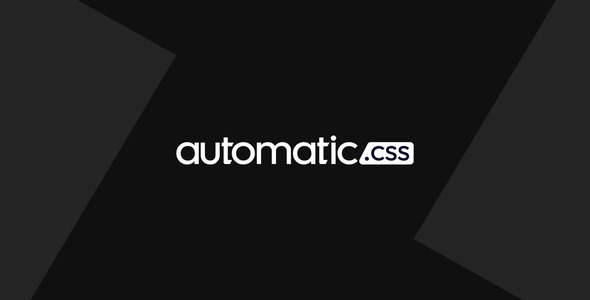Automatic.css 2.8.1

70+ Reviews
with 5 star Ratings

99% Customer
Satisfaction

7-Days
Money Back
Request update for this product.
$69.00 Original price was: $69.00.$2.99Current price is: $2.99.
- Version: 2.8.1
- Last Updated: 05/11/2024
- License: GPL
- 1 year of updates & unlimited domain usage
- Updates Will Come With A 24-48h Delay
- Original product with the lowest price ever
- Downloaded from original authors
- Instant delivery & fast downloading speed
- 100% clean and tested code
- Get this Product for Free in Membership
Automatic.css is an innovative CSS utility framework that streamlines the process of styling web pages. Designed to be user-friendly, flexible, and efficient, it offers a set of predefined classes that allow developers to rapidly design responsive and aesthetically pleasing websites without writing repetitive CSS code. Whether you’re building a simple landing page or a complex web application, Automatic.css helps in speeding up the development process and ensuring a cleaner codebase.
In this article, we’ll explore what Automatic.css is, how it works, its key features, and how to integrate it into your web development workflow.
What is Automatic.css?
Automatic.css is a utility-first CSS framework that combines the power of modern CSS with a focus on flexibility and scalability. Unlike traditional CSS frameworks, which offer pre-styled components, Automatic.css provides a set of utility classes that can be applied directly to HTML elements. This makes it a highly customizable framework that fits a variety of projects, from personal websites to enterprise-level applications.
The framework is designed to eliminate the need for writing repetitive CSS. Instead of defining custom styles for every element in a project, you can use utility classes to apply styling directly in the HTML markup. This speeds up the development process, reduces the size of CSS files, and ensures that your codebase is easier to maintain.
Key Features of Automatic.css
1. Utility-First Approach
One of the standout features of Automatic.css is its utility-first approach to styling. Rather than writing custom CSS for every element, developers can use utility classes to apply styles directly within their HTML. For example, instead of writing custom CSS rules to set the padding, margins, and font sizes, you can use predefined utility classes like .p-4 for padding and .m-4 for margins.
This approach reduces the need for complex, bespoke CSS and speeds up the development process by allowing you to apply styles inline with your HTML structure.
2. Responsiveness Built-In
Automatic.css comes with a built-in responsive design system, meaning it is ready to make websites mobile-friendly right out of the box. With the use of simple classes, you can make elements adjust their size, spacing, and layout based on different screen sizes.
For example, .sm:w-1/2 would apply a width of 50% to an element on small screens, while .md:w-1/4 could adjust the width to 25% on medium screens. This means developers can quickly make their websites responsive without writing media queries manually.
3. Minimalistic and Lightweight
Automatic.css is designed to be minimal and lightweight, ensuring that your projects won’t become bloated with unnecessary CSS. Unlike many other frameworks that come with hundreds of kilobytes of unused CSS, Automatic.css includes only the utilities you need, keeping file sizes small.
Moreover, Automatic.css can be integrated with tools like PurgeCSS to automatically remove unused CSS from your project during production, further optimizing the performance of your website.
4. Customizable and Extensible
While Automatic.css comes with a set of predefined utility classes, it also offers the flexibility to customize and extend the framework to suit your project’s needs. You can add your own utility classes, modify existing ones, or even integrate other frameworks alongside Automatic.css. This makes it an ideal solution for both simple websites and large, complex web applications.
If you need more advanced control over the design, you can configure your own design system by adjusting spacing, colors, fonts, and other styles in the configuration file.
5. Easy to Use and Learn
Automatic.css is beginner-friendly and easy to pick up for developers of all skill levels. With its well-documented classes and simple approach to styling, new developers can quickly understand how to use it to build clean, responsive layouts. The framework is also highly flexible, so experienced developers can dive deeper and customize it to meet their specific requirements.
How Automatic.css Works
Step 1: Install Automatic.css
The first step in using Automatic.css is to install it in your project. You can include it in your HTML file through a CDN or install it via npm if you’re using a build tool like Webpack.
- Using CDN: Simply add the following link to the
<head>section of your HTML file:html<link href="https://cdn.jsdelivr.net/npm/automatic.css/dist/automatic.min.css" rel="stylesheet">
- Using npm: If you’re using npm, you can install Automatic.css by running:
bash
npm install automatic.css
After installation, you can import the CSS file into your project:
javascriptimport 'automatic.css/dist/automatic.min.css';
Step 2: Apply Utility Classes
Once you have Automatic.css installed, you can start applying its utility classes directly in your HTML markup. For instance, to add padding to an element, you would use a class like p-4. The number after the utility represents the padding value, with higher numbers indicating larger amounts of padding.
Here’s an example of using Automatic.css to style a simple div:
<div class="bg-blue-500 p-4 m-4 text-white rounded">
Hello, this is a styled div using Automatic.css!
</div>
In the above example:
bg-blue-500sets the background color to a shade of blue.p-4applies padding around the content.m-4adds margin outside the element.text-whitemakes the text color white.roundedadds rounded corners to the div.
Step 3: Customize and Extend
For more advanced use cases, Automatic.css allows you to extend and customize its configuration. You can modify the default spacing scale, color palette, typography, and more by editing the configuration file.
If you’re using a build tool like Webpack, you can create a configuration file where you can define your custom utilities or override existing ones. This makes it easy to maintain consistency across your project while still having full control over the design.
Benefits of Using Automatic.css
1. Faster Development
By using predefined utility classes, you can speed up the process of styling your web pages. There’s no need to write custom CSS rules for each individual element, which means you can focus more on the logic and structure of your website.
2. Consistency
Automatic.css helps maintain consistency across your web project by providing a set of standardized utility classes. This ensures that all your elements are styled according to the same design system without any manual adjustments.
3. Maintainable Code
Since Automatic.css uses utility classes, your HTML becomes the primary location for styling, rather than scattering CSS throughout multiple files. This makes it easier to maintain and update your styling, as changes are more centralized.
4. Scalable
As your web project grows, Automatic.css remains scalable. You can customize or extend the framework as needed, ensuring that your styling remains consistent and efficient even as your project becomes larger.
Conclusion
Automatic.css is a game-changer for modern web development, providing a lightweight, flexible, and efficient way to style websites. Its utility-first approach allows for rapid development, while its minimalistic design ensures that your codebase stays clean and maintainable. Whether you’re working on a small personal site or a large web application, Automatic.css is an excellent tool to improve your workflow and boost productivity.
By integrating Automatic.css into your development projects, you can save time, maintain consistency, and deliver high-quality, responsive websites with ease. If you’re looking for a flexible, customizable, and fast CSS framework, Automatic.css is definitely worth considering.
You must be logged in to post a review.




Reviews
Clear filtersThere are no reviews yet.